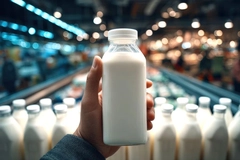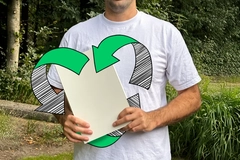From Push to Pull - Emerging New Structures in the Packaging Sector to Meet Future Demands

The deep integration of packaging in consumers' every day life with social implications, and its influence on ecology and economy, makes packaging an important component in achieving sustainable growth.
19/10/05 The packaging sector has to develop into a more a 'pull driven' sector focusing more on customer and downstream supply chain needs. Sustainable development and growth is another key theme that has to be integrated using a holistic approach encompassing the whole value chain/loop from material to consumer. The deep integration of packaging in consumers' every day life with social implications, and its influence on ecology and economy, makes packaging an important component in achieving sustainable growth. Packaging is a true multidisciplinary product and involves a broad area of research. Packaging also involves many stakeholders in the supply chain from production and manufacturing, through filling, warehousing and distribution, retail and consumers. Together they impose many demands on the packaging functionality that are often diverse and contradictory. The challenge is to work together in the value chain to continuously improve and respond to consumer pull.
Technology Foresight projects world-wide have recognised IT as the major issue that will affect nearly every aspect of business, industry and society. This will of course have strong implications also for the packaging sector. Directly, IT will change business-to-business and business-to-consumer communications. Indirectly, on a longer term, IT can change the very nature of the society we live in. It will also enable new networks and structures to be formed and support the continuously ongoing strive towards higher excellence in development, purchase, production, logistics, marketing and sales.
Companies in the packaging sector will have to utilise the potential benefits of IT more actively to remain competitive. IT can also be integrated into packaging as one way to create so called smart packaging. Technical development is fast and printable electronics in large series is likely to be realistic in a relatively near future. Cost of RFID chips possible to integrate into packaging is constantly decreasing. Other important issues according to the Technology Foresight projects concern the integration of advances in biotechnology and new materials into the business as well as a more cross-scientific approach in general.
Another factor is the growing globalisation and internationalisation. This will increase competition and the pressure to reduce cost, improve flexibility, quality and response when products will be sourced from a larger geographical market. For European high-cost countries this means stronger pressure to be innovative and add unique value to their products. This can partly be done through closer relations and partnerships with customers. Borderlessness is an important driver for the future. A number of business sectors are merging and previously clear-cut divisions between sectors are torn down. IT, telecom and media are largely merging into a giant information sector. Food retailers build restaurants within their premises, while restaurants offer take-away food. Powerful, large retail chains become competitors with their suppliers through the introduction of own brands. Many emerging markets are characterised by strong growth and plenty of business opportunities are waiting to be exploited. The packaging sector of tomorrow will be very different from today.
From push to pull
To put it simply, the packaging sector can be defined as consisting of three major types of companies:
- Packaging material suppliers
- Converters (converting packaging material into packaging)
- Packaging machinery suppliers
The traditional structure in the packaging sector has been material- and production-focused, i.e. a strong push orientation. New materials and technologies are looking for applications to fit into. For some companies a journey has started for many companies on the road towards higher customer orientation with focus moved from material to application, i.e. from push to pull. Parts of the packaging sector today can be described as application based, where converters have specialised in the product application. Understanding the particular application with its special product, logistics and market characteristics will be even more important in the future, in order to create unique selling points and add value. This also goes for packaging material suppliers, who often are enablers of added-value by supplying materials with adequate characteristics at the right price.
The packaging sector is now possibly entering the next phase of development with a transition from sales of physical products to provision of services, functions and value. Some Technology Foresight studies clearly points in this direction, but only a very limited number of companies have so far made any serious efforts. Instead of buying and selling boxes with a certain board quality, thickness, print and weight, the sector could offer product protection, sales appeal etc.
Third party and network logistics are growing. These services could well be expanded to include packaging too. There are a number of opportunities to be explored regarding the role of packaging and the packaging supplier in these networks. There seems to be a need for innovation, as there is room for substantial development of services in this field. There is a menu of services that could be provided in offering a high-value, knowledge-intense packaging and logistics service to the filler. Who takes the initiative to co-ordinate these services and launches them on the market as a "package", and how the market responds are open questions. Is it an existing actor or will new actors (broker-type) have to enter the scene to set this scenario in motion, is another open question. The packaging converter has a wide range of options regarding his role in the network. Some options are listed below ranging from running a pure production plant to being a co-ordinator and supplier of knowledge-intense service concepts.
- Production plant (subcontractor)
- Production & structural design (component/subsystem supplier)
- Packaging system solutions (integrated solutions to satisfy logistics, environmental and market demands)
- Packing system solutions including packaging ("turn-key supplier")
- Logistics service including packaging
Which route to choose depends upon the specific situation for each converter. How core business is defined is key input in this strategic process. Core business is a very central issue in the business environment of today and most likely even more so tomorrow. Part of a business strategic re-orientation process is normally to focus on core activities and sell or out-source non-core activities. Sometimes this means reduced integration. The options and strategies for integration are largely dependent on the business position in relation to core business. There are two main dimensions for expanding the business through integration: horizontal and vertical. Vertical integration can in turn take two directions, namely upstream and downstream in the supply chain.
The cycle of companies looking for opportunities to integrate both horizontally and vertically is likely to continue, maybe at an even higher pace in the future. Integration moves in industry have a very dynamic character, and it is possible to find examples on all directions of integration. The converting sector in general is not so consolidated and structured as its customers and suppliers are. It is therefore in danger of being "squeezed" between customers, asking for higher value at lower cost, and suppliers unwilling to reduce prices. With reduced margins and a need to develop new and more complex packaging solutions, the packaging sector may face difficulties. Can the packaging sector survive in the long run in such an environment? There are a number of possible scenarios. Further consolidation to be on more on equal terms with customers and suppliers is one scenario. This is a route already entered by parts of the packaging sector, but there may be obstacles to come on "equal terms" with some customers, given the consolidation and size of some important customer sectors such as food and pharmaceuticals. Packaging companies may also be acquired by either suppliers or customers. Suppliers may want better access to and communication with important markets, e.g. paper & board and plastics producers where roughly almost half of all production ends up in packaging applications. For metal producers the share of metal ending up in packaging is low, but there may be niche producers specialised in packaging. Acquisition from customers is also feasible, especially in those areas where product and packaging integration is strong. New actors may also enter the scene offering e.g. logistics and packaging services and/ or marketing and packaging services. Packaging companies, customers, suppliers and providers of related services (e.g. logistics and marketing) may well have to form new networks, and adopt new strategies to remain competitive.
To conclude, there is a large future potential for the packaging sector to supply innovative, value and knowledge intense packaging products and services, but requires these to be produced using less resources. To achieve this, new networks, partnerships and re-structuring of the sector may well be necessary and the focus have to change from push to pull. As an example, logistics related packaging providers may merge or form partnerships with logistics service providers, who then could extend their services to cater for companies wishing to out-source their whole packing and logistics process.











